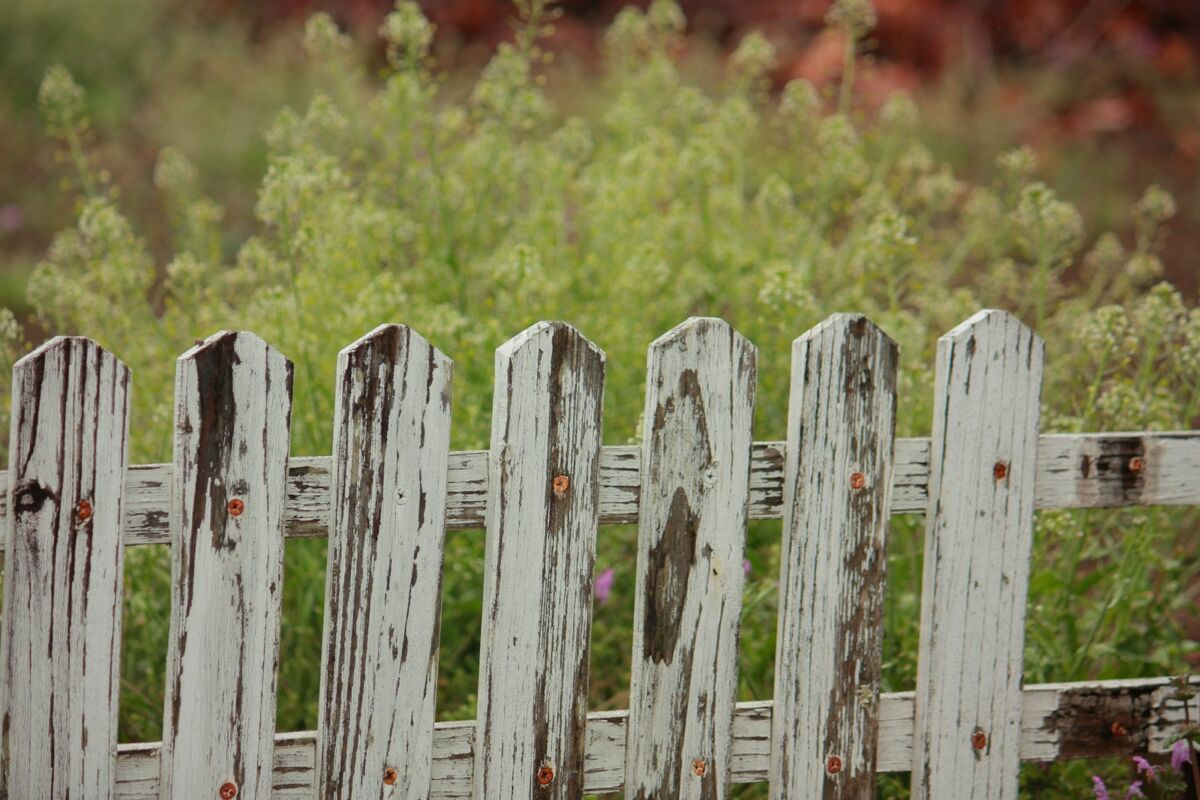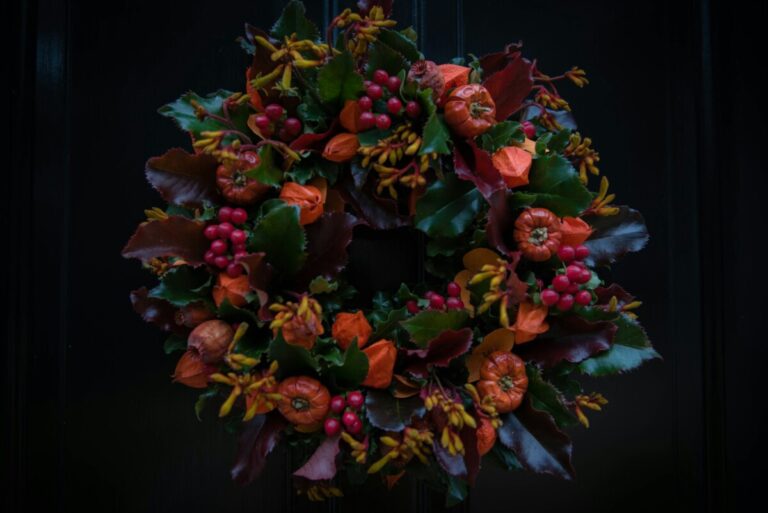A wooden fence anchors a space in a way few other elements can. It frames a yard the way trim frames a painting—quietly, but with purpose. I’ve been noticing how much a fence can actually set the tone of a space. Rustic or modern, playful or private, the right fence becomes more than a boundary—it becomes part of the sanctuary.
So I went on a little design deep-dive. The goal? Fresh, doable backyard fence styles that feel thoughtful and beautiful without trying too hard. Some are DIY-able weekend projects—perfect for anyone looking for DIY wooden fence design inspiration—while others are more aspirational. But But all of them?e backyard charm.
Here are wooden fence designs and wood fence ideas to spark your outdoor imagination.
1. Horizontal Slats with Gaps
Slim wooden slats lined up horizontally can shift your whole backyard vibe—suddenly, it feels modern, calm, a little like a boutique hotel patio. The small gaps between each board let sunlight and breezes sneak through, softening the structure without giving up privacy.
You can keep the wood raw for a laid-back, beachy look or stain it dark for something sleeker. Either way, it adds a sense of openness without leaving you exposed.
It’s one of the most popular modern wood fence ideas for backyard spaces looking to balance style and function.
2. Shou Sugi Ban Panels
Charred wood sounds intense—but the effect? Gorgeous. Shou Sugi Ban is a traditional Japanese method of burning wood to preserve it, and the result is a deep, smoky black finish with a subtle sheen.
Use it in fence panels for drama and texture. The surface has this alligator-skin kind of look that’s both rustic and refined. And bonus: it naturally resists bugs and weather, no paint or sealant required.
3. Woven Wood Fencing
Imagine taking long, thin wood strips and weaving them like fabric—that’s the vibe here. Woven wood fencing brings an earthy, handmade texture to your yard, and it stands out without shouting.
The pattern plays beautifully with sunlight, casting dappled shadows that shift as the day goes on. It’s also surprisingly sturdy, especially when framed with thick posts for contrast.
4. Lattice-Topped Fence
Sometimes you want privacy… but not all the way up. A lattice-topped fence strikes that perfect middle ground. The lower half keeps things cozy and tucked-in, while the open grid above lets in sky and air and glimpses of green.
It feels garden-y and classic—especially if you let a vine or two climb across the top. M Morning glories or jasmine?nstant charm.
5. Reclaimed Wood Patchwork
Using different types of reclaimed wood—barn boards, pallet slats, old floor planks—adds character you just can’t fake. Each piece brings its own grain, tone, and little imperfections that tell a story.
Lay them out like a patchwork quilt, mixing sizes and finishes for that perfectly undone look. It feels warm, creative, and slightly nostalgic—like your fence remembers all kinds of past lives.
6. Split Rail Simplicity
This one’s a classic for a reason. Split rail fences feel open and friendly, more suggestion than separation. Rough-hewn rails stacked loosely between posts look especially good on large lots or near open fields.
It’s not about privacy here—it’s about presence. Think gentle boundaries and wide views. Add some wildflowers or tall grass nearby and the whole thing hums with rural charm.
7. Painted Pastel Pickets
White picket fences are sweet, sure—but soft color makes them sing. A picket fence in sage green, pale coral, or dusty lavender adds a whisper of whimsy without overwhelming the space.
The trick is keeping the color muted—think faded seaside town, not fresh-from-the-paint-store. It works beautifully in gardens with soft blooms and gives off a “come sit for a while” kind of energy.
8. Zigzag Fence Pattern
Straight lines aren’t your only option. Try arranging your boards in a zigzag or chevron pattern for a fence that looks more like art than utility.
The angled layout adds motion and shadow, catching the eye even when the color is neutral. Great for accent walls, small yards, or anywhere you want to break out of the usual. It’s one of those touches that makes people look twice.
9. Vertical Slats with Alternating Widths
This one plays with rhythm in the subtlest way. Instead of evenly spaced boards, try mixing narrow and wide slats in a repeating pattern. It adds texture without adding clutter.
The vertical lines draw the eye upward, which makes even a small yard feel a little taller, a little more open. And the changing widths keep things from feeling too uniform—it’s structure with a wink.
10. Live Edge Panels
Forget clean cuts—embrace the natural wave of the wood. Live edge fencing leaves the raw, curving edge of the board intact, so each panel has its own organic shape.
When lined up together, they create a soft, undulating silhouette that feels like it grew there on its own. It’s the kind of detail that makes your yard feel more like a forest hideaway than a backyard.
11. Diagonal Board Layout
Angling your boards diagonally across the fence changes the whole mood. It adds movement, catches light differently, and just looks a little more design-forward.
You can go full chevron, cross two directions for a criss-cross look, or just slant them one way for a clean, tilted finish. Either way, it turns a flat surface into a visual statement.
12. Pergola-Topped Fence
When a fence and a pergola fall in love, this is what you get. Adding a pergola-like top beam across your fence adds both shade and architectural charm. It creates a gentle overhang that makes the space feel more enclosed—almost like a secret garden.
Let vines trail down from above, hang a lantern or two, and you’ve got a dreamy little passageway without building a full structure.
13. Black Stained Panels
Sleek, bold, and kind of underrated. A black-stained fence doesn’t fade into the background—it frames the whole space like a gallery wall.
Greenery pops, flowers seem brighter, and the lines of the fence feel sharper and more intentional. It’s a confident choice, but it pays off in mood and contrast.
14. Rustic Pallet Walls
If you’ve got access to old pallets, you’ve got the makings of a fence with loads of charm. Stacked horizontally or vertically, pallet wood creates a scrappy, lived-in look that feels casual and welcoming.
Give it a light sand and a matte finish if you want a little polish—or leave it raw and let the weather do its thing. Either way, it’s budget-friendly and full of character.
15. Floating Fence with Spaced Posts
Here’s a cool visual trick: wide posts with “floating” slats set between them—spaced just enough to let light in. The boards aren’t attached in a traditional run; they’re suspended in sets, which makes the whole thing feel more architectural.
It’s modern but not cold. Clean but not sterile. Great for side yards or anywhere you want both privacy and personality.
16. Built-In Planter Fence
A fence that gardens with you? Yes, please. Adding planter boxes right into the lower section of your fence lets you grow herbs, flowers, or trailing greens without taking up extra space.
It’s a functional upgrade that brings life to the wall. Picture soft basil brushing against the wood, or trailing nasturtiums spilling over the edge. Practical and pretty—what’s not to love?
17. Log Slice Mosaic
This one feels like it came straight from a woodland daydream. Cut logs into slices—anywhere from a few inches thick to wafer-thin—and stack them into a panel like coins in a jar.
The mix of rings, grains, and warm tones turns your fence into a natural art piece. It’s especially striking in garden nooks or near a fire pit, where the wood adds warmth even before it’s touched by flame.
18. Board and Batten Style
Simple, solid, and satisfyingly structured. Board and batten fencing alternates wide vertical planks with thin battens that cover the seams. The look is crisp but not cold—like an old barn got a modern refresh.
Stained wood gives it richness, while painted versions lean more classic. It’s great for full-height privacy without losing a sense of texture or craft.
19. Arched Top Fencing
Swap the straight lines for a gentle curve, and suddenly your fence feels like part of a storybook. Arched tops soften the look of solid panels and guide your eyes in a quiet sweep across the yard.
They work especially well around garden beds, patios, or entry gates—anywhere you want the edges to feel a little more inviting.
20. Slatted Corner Nook
Need a moment of peace? Build a tucked-away corner out of slim, vertical slats—tight enough for privacy, spaced just enough to let air and dappled light through.
Add a bench, a cushion, maybe a wind chime or small plant shelf… and you’ve got a mini sanctuary within your sanctuary. Perfect for morning coffee or evening resets.
21. Painted Mural Fence
Blank wood panels = giant outdoor canvas. You don’t need to be a pro to create something fun, either—geometric shapes, ombré fades, or leafy stencils can turn a fence into a piece of art.
Murals add soul to a space. Even a few hand-painted vines or a quote you love can make the backyard feel more like yours.
22. Driftwood Assembly
Driftwood brings a wild, weathered beauty that no store-bought board can match. Collect pieces from the shore (or a beach-themed salvage yard), and arrange them like puzzle pieces into a loose panel or fence run.
It’s coastal without being kitschy, and every piece has that sun-bleached, wave-worn look that only time can give. Add some sand underfoot and a hammock nearby—you’re halfway to vacation.
23. Rustic Twig Fence
This one’s pure cottagecore. Gather sturdy twigs, branches, or saplings, and lash them together with wire or twine between upright posts. It won’t block the view—but it adds texture and charm in spades.
Great around veggie gardens or flower beds. And when paired with wildflowers or stone paths? It looks like it wandered out of a folk tale.
24. Geometric Cut-Out Panels
For a fence that doubles as sculpture, try panels with laser-cut geometric patterns. Think honeycombs, overlapping circles, or angular grids. You can use wood directly or mount cut-out screens into wooden frames.
By day, light shines through in shifting shapes. By night, backlight them and they become glowing patterns that dance across the garden. It’s a high-design moment that still feels warm and grounded.
25. Bench-Back Fence
Here’s a two-for-one that’s both smart and sweet. Attach a built-in bench right against your fence—either as part of the design or added later with matching wood. It instantly turns a plain stretch of wall into a little sit-and-stay-a-while spot.
Toss on a cushion, maybe a throw, and you’ve created a quiet corner for sipping, reading, or watching the garden grow.
26. Framed Horizontal Panels
Adding a slim frame around each section of your horizontal fence gives it that polished, magazine-worthy finish. Think of it like matting a photo—it sharpens the edges and makes the whole thing feel more intentional.
Stain the frame darker for contrast or keep it uniform for a seamless, tailored look. Either way, it adds a touch of craft to clean lines.
27. Tall and Tapered
Fence height doesn’t have to be one-note. Create a soft step-down effect by gradually lowering the height from one end to the other. It makes transitions between spaces feel more natural—especially between your yard and a neighbor’s.
It also breaks up visual monotony, adding a quiet flow to your fence line that’s easy to love but hard to put your finger on.
28. Tiered Step Fence for Sloped Yards
If your yard isn’t flat, don’t fight it—work with the slope using a stepped fence. Each panel stays level, but the posts “step down” the grade. It creates a satisfying, rhythmic drop that mirrors the landscape.
It’s clean, functional, and a huge improvement over trying to force a straight run on uneven ground. Plus, it adds a layered look that makes the whole space feel more dynamic.
29. Chevron or Herringbone Layout
Arrange your boards in chevrons or herringbone, and the whole fence becomes a pattern in motion. It’s a subtle shift from traditional lines, but it catches the light and draws the eye with a kind of quiet rhythm.
Perfect as an accent wall or to elevate a focal area—like behind a fire pit or dining zone. One of those details that makes everything feel just a bit more designed.
30. Cedar Privacy Fence with Top Gap
This one’s all about balance—full coverage on the bottom for privacy, with a slim open strip along the top to keep things light. That little top gap lets the fence breathe and avoids the boxed-in feeling taller walls can sometimes bring.
Cedar adds natural warmth and ages beautifully over time, softening into a silvery gray that somehow looks better every season.
31. Painted Strip Accent
Keep your fence classic, then paint a single horizontal stripe through the center in a bold or earthy tone. It’s a small detail, but it breaks up large panels in a way that feels graphic and modern.
Think of it like a belt on a great outfit—subtle structure with a side of style.
32. Modular Fence Panels
Think of these as the building blocks of flexibility. Instead of one continuous fence, modular panels create sections—each framed individually and connected by strong posts. You can mix materials (wood and metal, wood and glass), alternate panel patterns, or change heights mid-run.
It’s modern, tidy, and perfect for customizing your space without reworking the whole structure.
33. Slatted Shadowbox Fence
This style works double-time—privacy on both sides, airflow down the middle. The boards alternate on either side of the central rail, creating a layered effect that feels both solid and breathable.
It’s ideal for shared yards or side fences where you don’t want one neighbor staring at the “good side.” From the right angle, the overlapping slats even cast soft, moody shadows that shift with the light.
34. Vertical Gardens on Fence Walls
Why stop at just enclosing the yard when your fence can also grow things? Add mounted planter boxes, pocket panels, or even a few staggered shelves—and suddenly the whole wall is blooming.
Great for herbs, succulents, or flowers that trail and tumble. Plus, it’s a smart way to green up a small space without giving up any ground.
35. Stained Ombre Effect
Gradient fences are surprisingly easy—and wildly pretty. Start with a dark stain at the base and work your way up to something lighter (or vice versa). The shift in color adds softness, like the fence is fading gently into the sky.
It’s subtle enough not to scream “look at me,” but interesting enough to make guests pause mid-sentence.
36. Slatted Curve Fence
Instead of building in straight lines, bend your boards into a soft curve. It takes a little more planning, but the effect is quietly dramatic—especially when it wraps around a corner or frames a garden bed.
The curved shape plays beautifully with light and shadow, making the fence feel more like a sculpture than a structure.
37. Rope-Threaded Panels
Mix wood with thick nautical rope for a fence that feels equal parts coastal and clever. Weave the rope horizontally through holes in upright posts, or use it as a soft border inside wooden frames.
The look is textured and relaxed, like something you’d spot near the water or on a trail through the dunes. Especially nice with weathered wood and sandy tones.
38. Windowed Sections
Incorporate framed “windows” into your fence—clear acrylic, decorative ironwork, or even just open space bordered by wood. It keeps things connected without fully opening up the view.
Great for dividing garden zones or softening the edge between you and the world. It adds a thoughtful touch that says: privacy matters, but so does perspective.
39. Sculptural Post Caps
Fence posts don’t have to stop at the top. Try capping them with something unexpected—lanterns, mini birdhouses, antique finials, even small planters.
It’s a tiny detail, but it makes the whole fence feel curated. Like you didn’t just put it up—you finished it.
Bring the Sanctuary to Life
Your fence doesn’t need to disappear into the background. It can guide the eye, frame your space, and add personality to your entire outdoor vibe. With the right style (and a little imagination), even a basic boundary becomes part of the beauty.
Now, time to grab a sketchpad or stroll around your yard. Inspiration’s already waiting.




